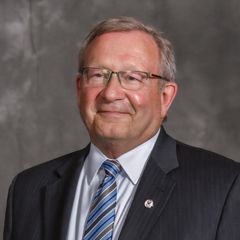Boards of pharmacy can face unexpected challenges while working to protect the public health. Here, board executive directors talk about how they worked around these obstacles.
Steven W. Schierholt, Esq
Executive Director, State of Ohio Board of Pharmacy
How long have you served as executive director of the State of Ohio Board of Pharmacy? What was your prior role?
I have been executive director for almost seven years. Previously, I was assistant superintendent of the Ohio Bureau of Criminal Investigation, an agency under the Ohio attorney general that manages the state’s criminal database and criminal records repository, operates crime labs throughout the state, and has a large investigation staff. I was in charge of each of those operational divisions.
What is one of the most significant challenges that your Board addressed in the past year?
Ohio and other states across the country are still in the middle of an opioid epidemic. Prior to the coronavirus disease 2019 pandemic, that was front and center for us. We believe the Board plays a role in and contributes to the state’s efforts to combat that epidemic.
What actions were taken by the Board to address the issue?
One of the first things I think of are prescriber limits and how, despite climbing overdose death rates, the number of deaths attributable to prescription controlled substances has gone down in Ohio year after year. We are not declaring victory, but the Board is proud of the contribution it has made in policing pill mills, educating the pharmacist community, and encouraging pharmacists to be a part of the solution.
For example, the Board created a pocket card for pharmacists who might not be comfortable having difficult conversations with a patient exhibiting drug-seeking behavior. One side of the card articulates the Ohio law that deals with corresponding responsibility; the other side provides substance abuse treatment options. A pharmacist can hand the pocket card to that patient and say, “Look, I can’t fill this. Here are the rules; here are the laws. And, by the way, on the back are some treatment options if you believe you may benefit from treatment.”
While there initially was some pushback on prescribing limits, we received no complaints from pharmacists about the Board’s requirements to check Ohio’s prescription monitoring program (PMP) and be part of the solution. We are very proud of Ohio’s PMP – the Ohio Automated Rx Reporting System (OARRS) – and are working tirelessly to make it an indispensable health care tool. Ohio was the first state in the country to integrate a PMP into the clinical workflow and to fund it. The number of doctor shoppers in Ohio has dropped precipitously, in part due to working OARRS into the clinical workflow.
What other key issues has the Board been focusing on?
The Board has spent a lot of time making sure that its administrative rules reflect the changes that are occurring in the practice and regulation of pharmacy. We are doing everything we can to make sure that our rules reflect reality and are easy to follow. Trying to harmonize federal and state regulations can be difficult in practice, so we are upping our communication to our licensees and other health care professionals who are impacted by the Board’s rules. In addition, in the last six and a half years, we have rebranded and redesigned our websites. We want them to be one-stop sources of information for the pharmacy community as well as for the prescribing and medical communities.
What insights do you have for other states?
I think it is incumbent upon the boards of pharmacy to work with other entities, to the extent that their laws allow or require, to fight diversion and overprescribing. The data that we obtain from our PMP are astounding. Our OARRS staff can look at the data and identify prescribers who are operating outside the rules or law. It might be easier to throw up your hands and say, “Well, here is my piece of the puzzle,” and that is it. But if you work with other agencies in your state and put all the pieces together, I think you can make a greater difference.
This interview was originally featured in the November/December 2021 edition of Innovations.
